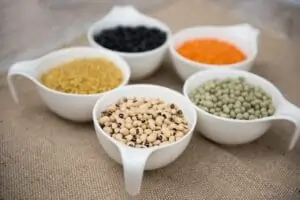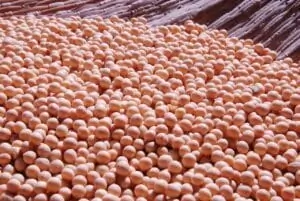What are Proteins?
[ez-toc]
Proteins consist of linear sequences of amino acids that are connected by peptide bonds. The arrangement of these amino acids carries the information needed to a protein molecule with a distinctive three-dimensional structure. The 20 amino acids commonly found in proteins are connected together by peptide bonds.
On a chemical basis:
Proteins are the unbranched polymers of L α- amino acids. Another definition is “The monomeric units, amino acids, combine through peptide bonds and form long chains called polypeptides, which in turn form proteins.”
Proteins are vital to life because all living organisms are made up of cells, and a cell’s composition is about 70-90% water, 10-15% proteins, 5-7% nucleic acids, 3% carbohydrates, 2% lipids, and almost 1% ions. So, 50% of the dry weight of the cell is protein.
” Proteins are the most abundant organic molecules found in living cells or living organisms.”
Historical background:
The term ‘Proteins’ was derived from the Greek word ‘Proteios’ by a Swedish chemist Berzilius in 1938. Proteins mean ‘primary’ or ‘holding the first place’. This name was suggested for the organic molecules which have diversified and important functions in the body, i.e., proteins. This term was first used by the Dutch chemist Mulder in 1938 for a high molecular weight nitrogen-rich compound.
Composition of proteins:

Some other elements like phosphorus, iron, copper, iodine, magnesium, manganese, and zinc are also present in small proportions.
Functions of proteins:
- Proteins act as enzymes to regulate ( inhibit or enhance ) many metabolic reactions in our body.
- They play an important role in the neuroendocrine system (the endocrine system works in collaboration with the nervous system to form the neuroendocrine system ) as hormones, hormone-releasing and inhibiting factors, neurotransmitters ( chemicals that transmit nerve impulses), and neuromodulators ( chemicals act together with neurotransmitters and enhance responses of the receptors ).
- Monomeric units of proteins i.e.; amino acids take part in cellular functions like nerve transmission and biosynthesis of nucleic acids (purines and pyrimidines), porphyrins (for hemoglobin), and urea.
- They are major metabolic transporters of the body as they transport oxygen, iron, fatty acids, and bilirubin in the body.
- They form a contractile system of our muscles and help them contract and perform functions.
- They also work as a house for iron and oxygen.
- They provide support, structure, strength, and protection to our bones, ligaments, hair, and nails.
- As hormones, they regulate our body’s physiological and cellular functions.
- They also provide strength to our immune system.
- They also function in genetic control ( in transcription and translation ).
Thus, due to all these diversified functions proteins are regarded as ‘the working horses of the cell’.
Sources of proteins:
- Eggs

- Beans

- Nuts

- Lentils

- Seafood

- Yogurt

- Milk
- Cheese
- Quinoa

- Tofu

- Almonds
- Fish
- Salmon

- Tempeh

- Legumes
- Soy

- Beef
- Seeds
- Chicken
- Mutton










Good work